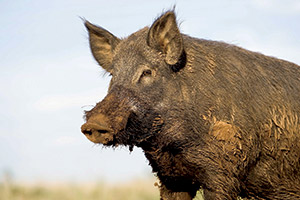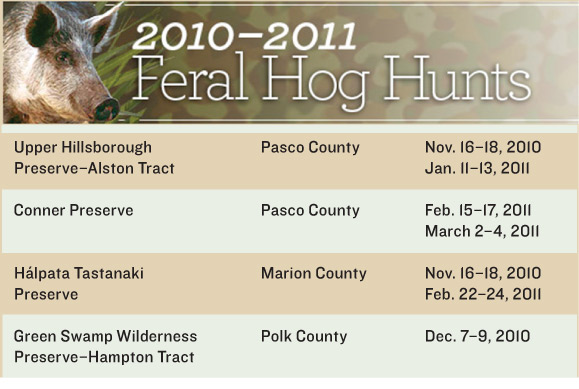Hunters can apply online beginning Oct. 11 for permits to hunt wild hogs on District properties.
Properties in Pasco, Marion and Polk counties will open for scheduled wild hog hunts, with the first hunt planned for November and the last hunt in March.
Starting 9 a.m. on Oct. 11, online permit registration for the 2010–2011 hog hunts will be available on a first-come, first-served basis at WaterMatters.org/hoghunts. Each hunt has a limited number of available permits. A $50 nonrefundable fee must be paid for each permit (Visa, MasterCard, American Express, Discover or Diners Club only). Cash or checks cannot be accepted. Permits will be mailed to registrants on or about Oct. 25, 2010. Permits are transferrable.
The District-managed properties will be temporarily closed to the public during the hog hunts. Only permitted hunters will be allowed access.
Feral hogs are an invasive exotic species that negatively impact wetlands and other habitats by “rooting” up the soil while searching for food. They prey on native wildlife, compete with native species for food and transmit diseases to other wildlife, livestock and humans. Hogs also may help spread exotic plant species by transporting seeds and providing germination sites through rooting.
Removing the animals from the landscape through hunting or trapping is the only viable method of hog control in Florida. The 2009–2010 series of hunts removed hundreds of hogs from five different tracts of land throughout the District.
In addition to obtaining a permit online, rules and maps of the areas where the hunts will take place are available on the District’s web site at WaterMatters.org/hoghunts.

Feral Hog
Frequently Asked Questions
What is a feral hog?
Feral hogs are wild animals that originated from domestic livestock.
What kind of damage can a feral hog do?
They negatively impact wetlands and other habitats by “rooting” up the soil searching for food. They prey on native wildlife, compete with native species for food and transmit diseases to other wildlife, livestock and humans.
How did feral hogs get here?
Hernando de Soto brought the first hogs to the Atlantic Coast of Florida in 1539.
How many hogs exist on District lands?
Determining the exact number of hogs on any large tract is impractical. Land managers monitor population trends through visual sightings of animals and observing trends in habitat destruction.
What do feral hogs eat?
Feral hogs are omnivorous, which means they eat both plant and animal matter. Plant material makes up the bulk of the hog’s diet, with acorn and palmetto mast being a large seasonal component. Animal material in the diet consists of invertebrates and small vertebrates, such as amphibians and the eggs of ground nesting birds.
How big does a feral hog get?
A feral hog may exceed 200 pounds, but the average is less than 100 pounds.
Are feral hogs dangerous?
Like any other wild animal, hogs can be dangerous if threatened or with young.
Can I get sick or can my pet get sick from contact with a feral hog?
Yes. Hogs can carry a number of diseases transmittable to humans or domestic animals. Primary diseases of concern in Florida are brucellosis and pseudorabies, which are generally spread through direct contact with an infected animal.
Are there any natural predators of feral hogs?
Large hogs have few predators on District lands. Smaller hogs may be preyed upon by bobcats and coyotes. Man is the primary predator of hogs.

